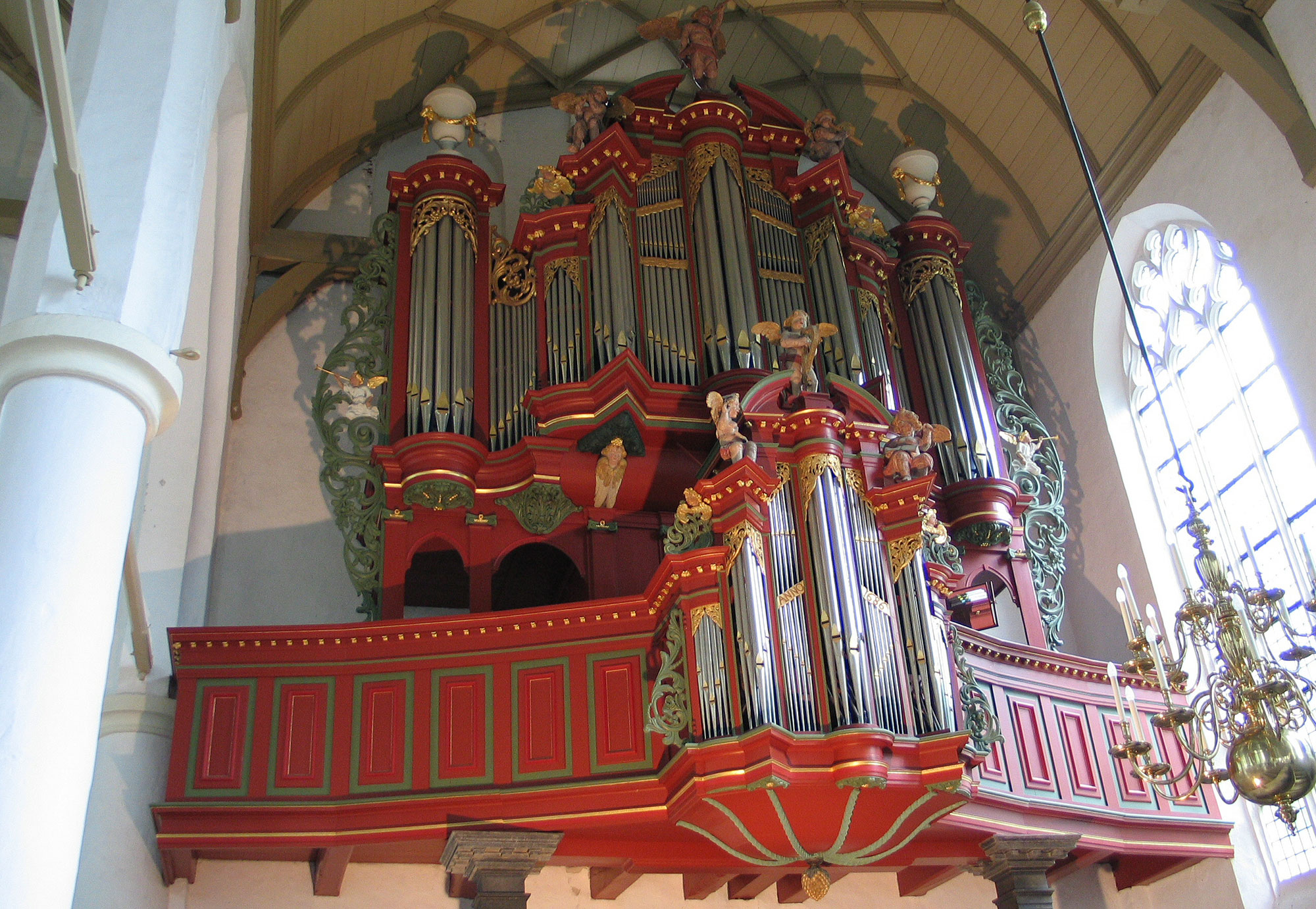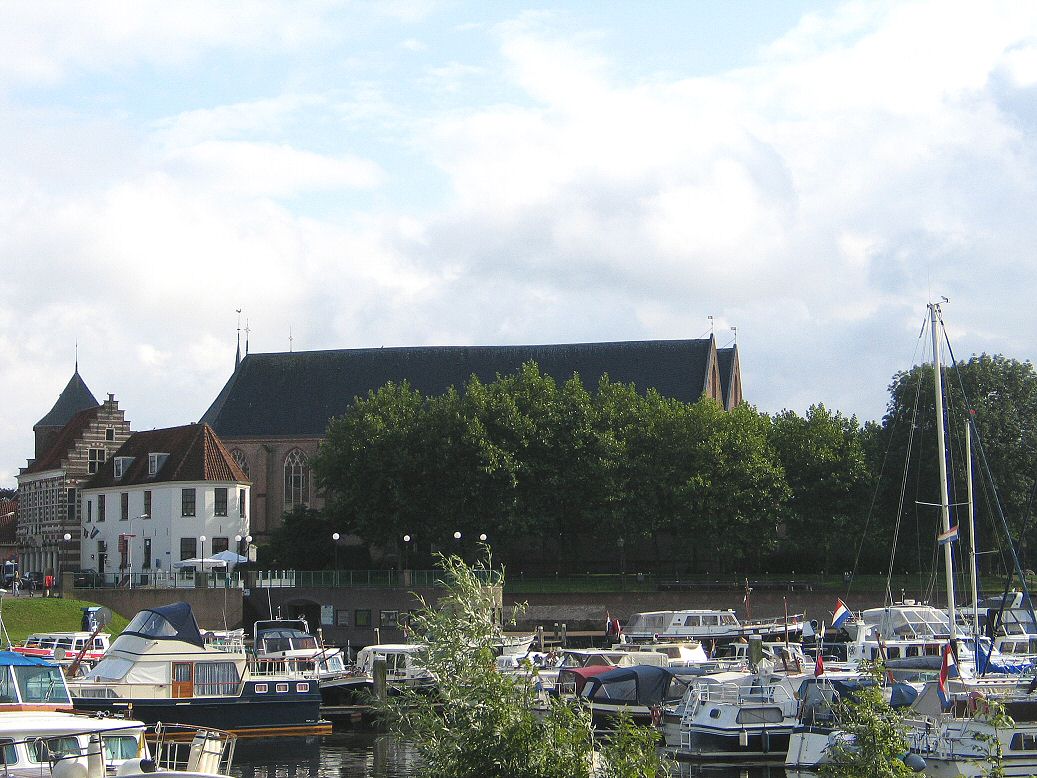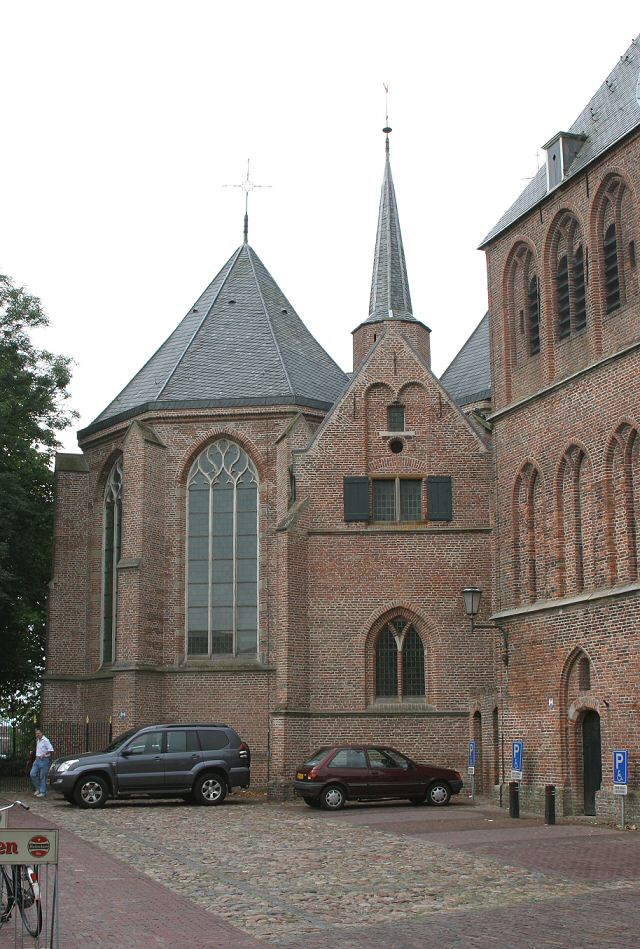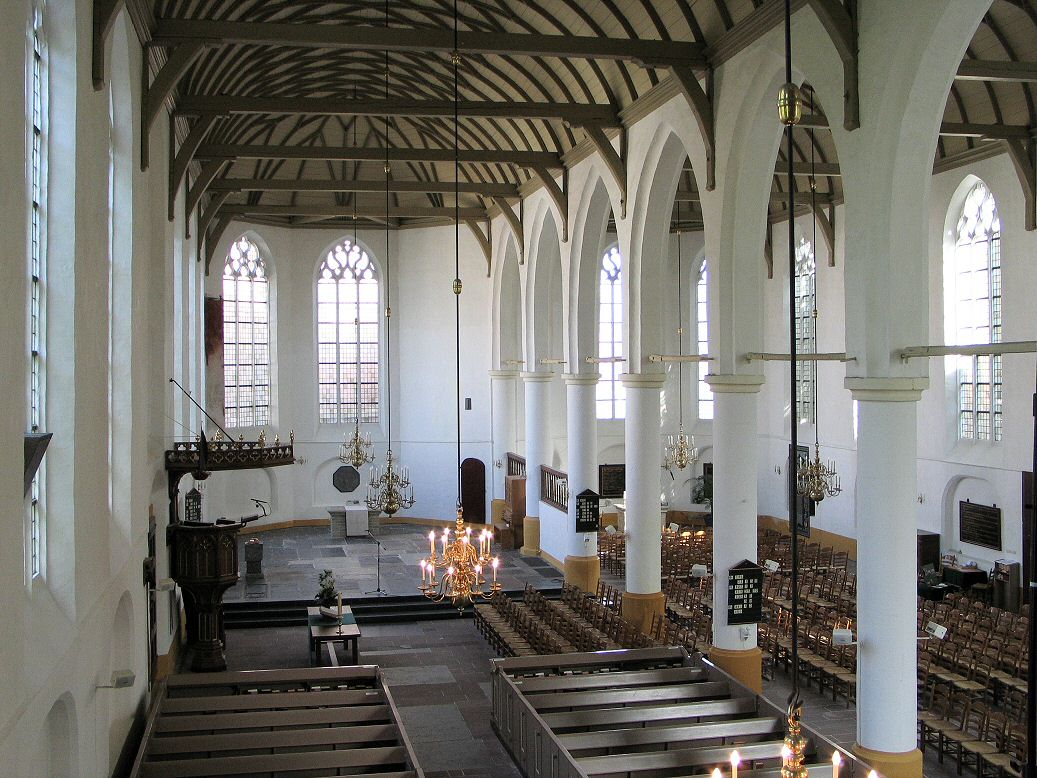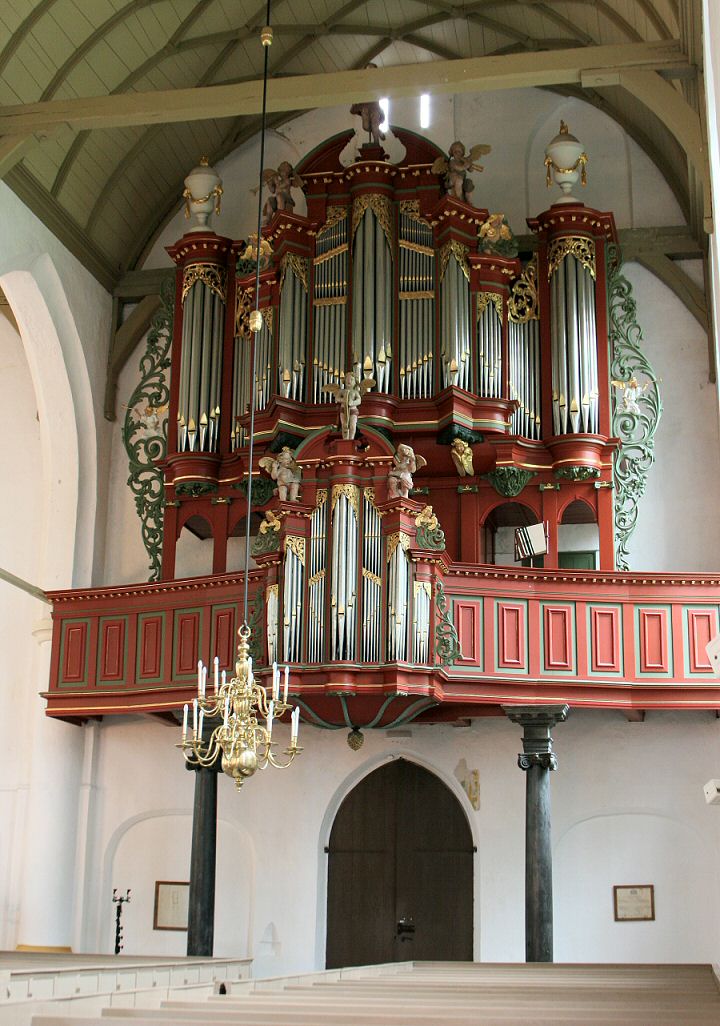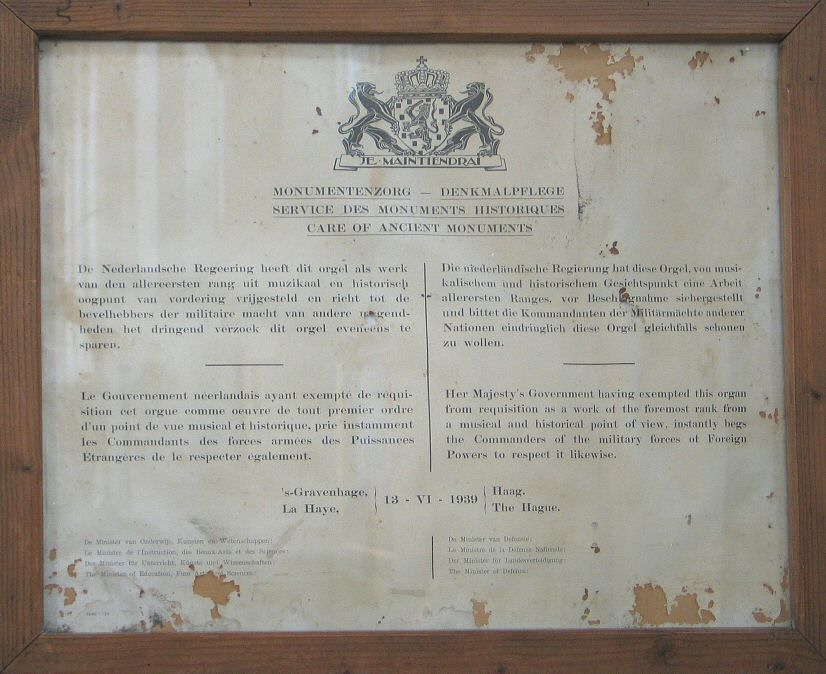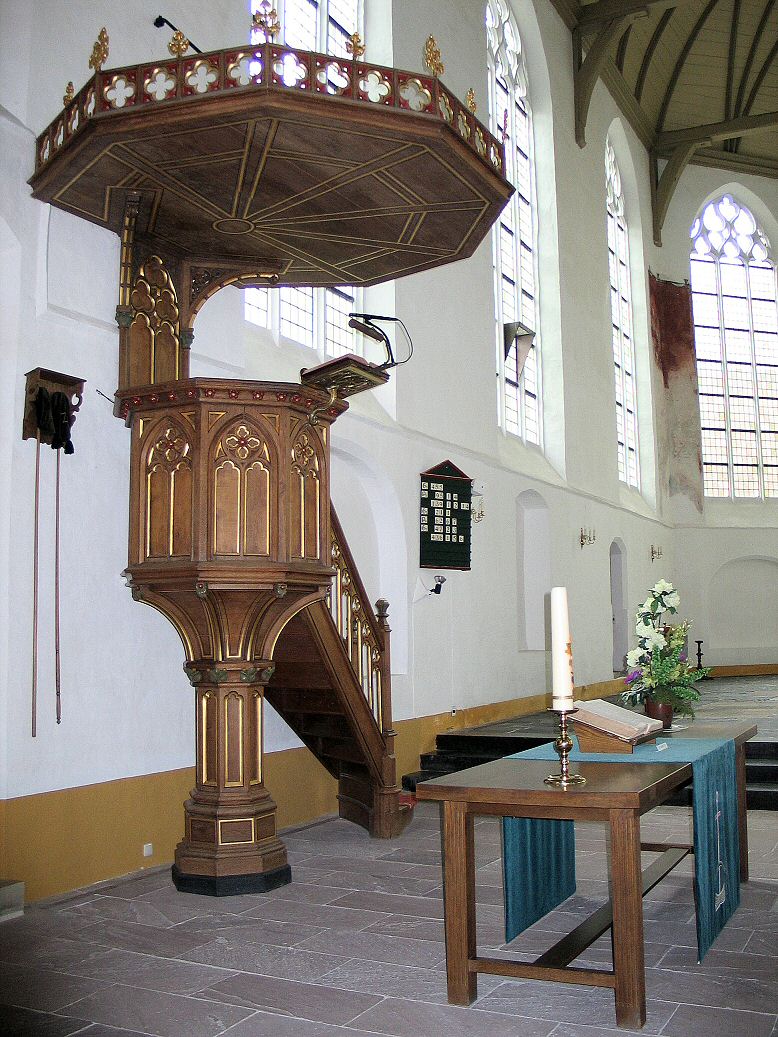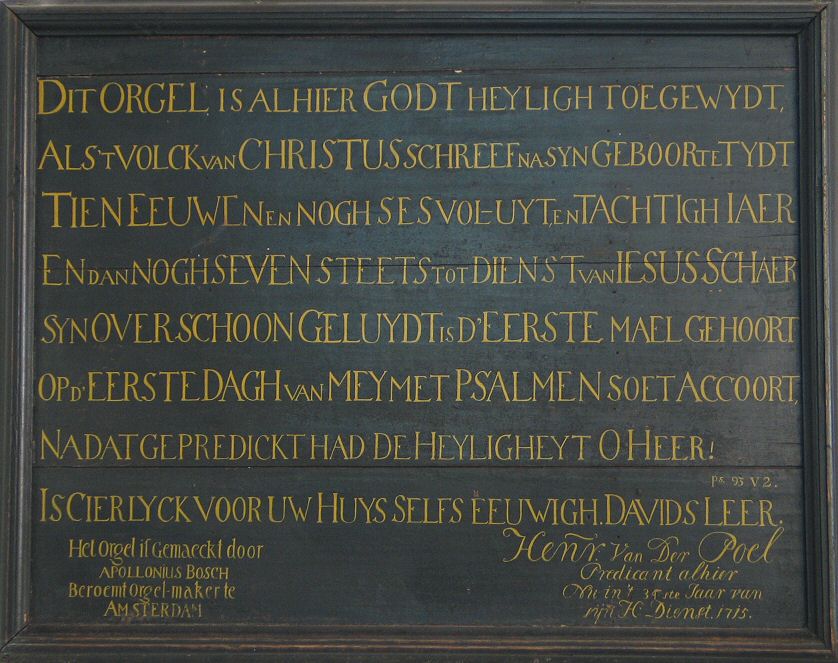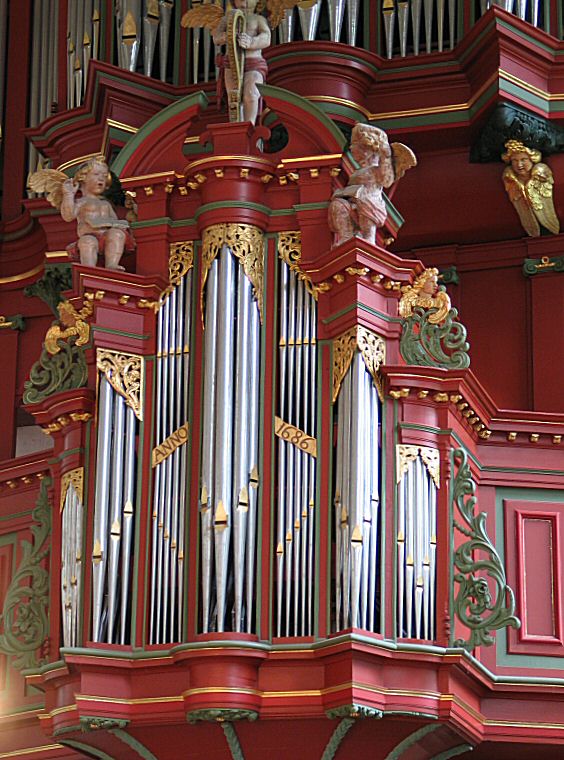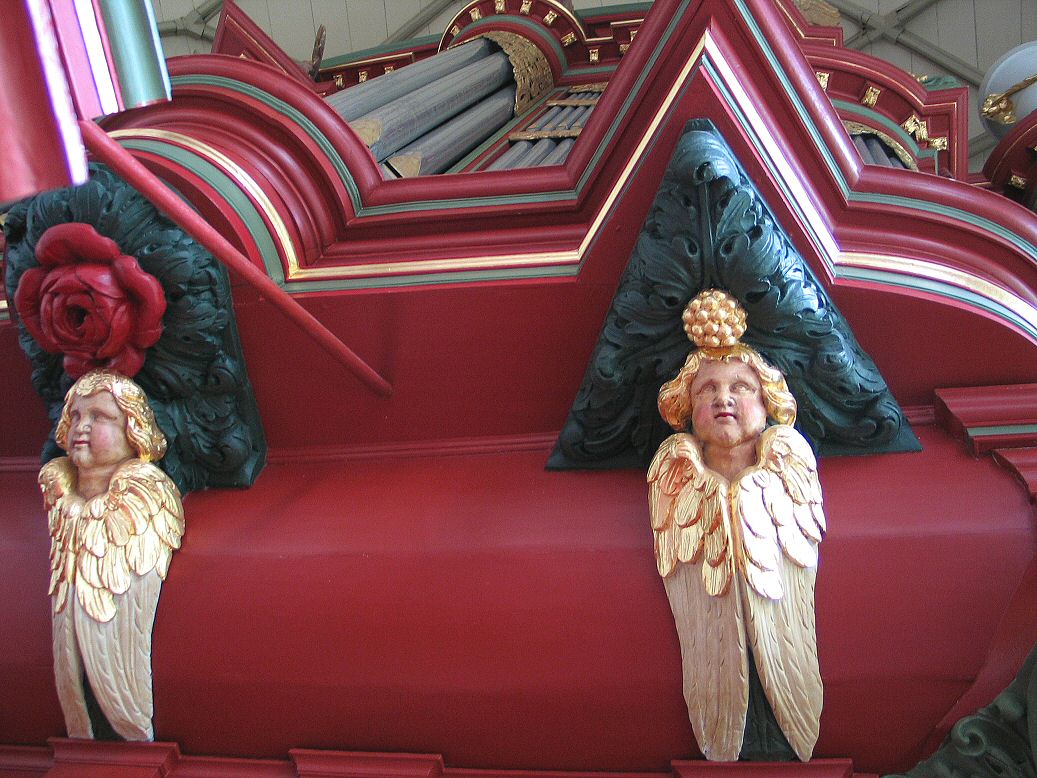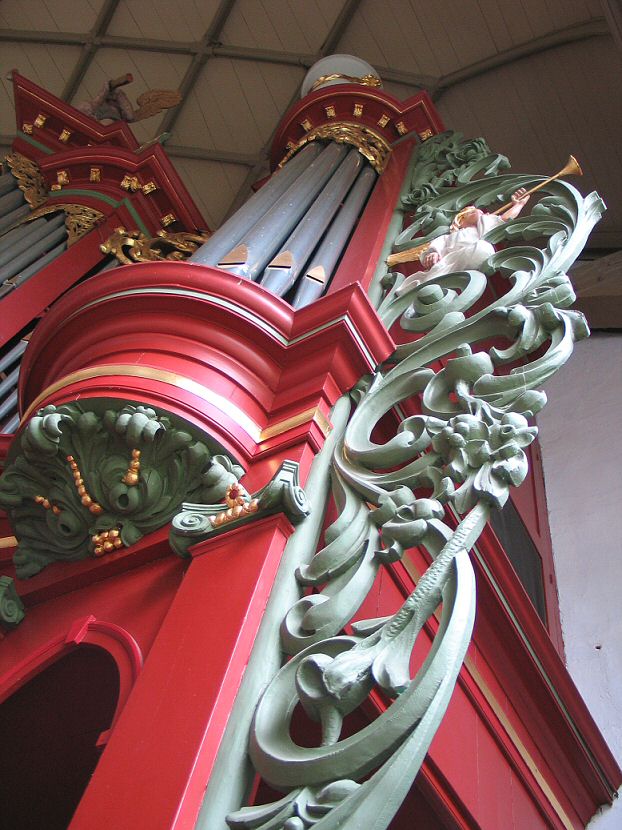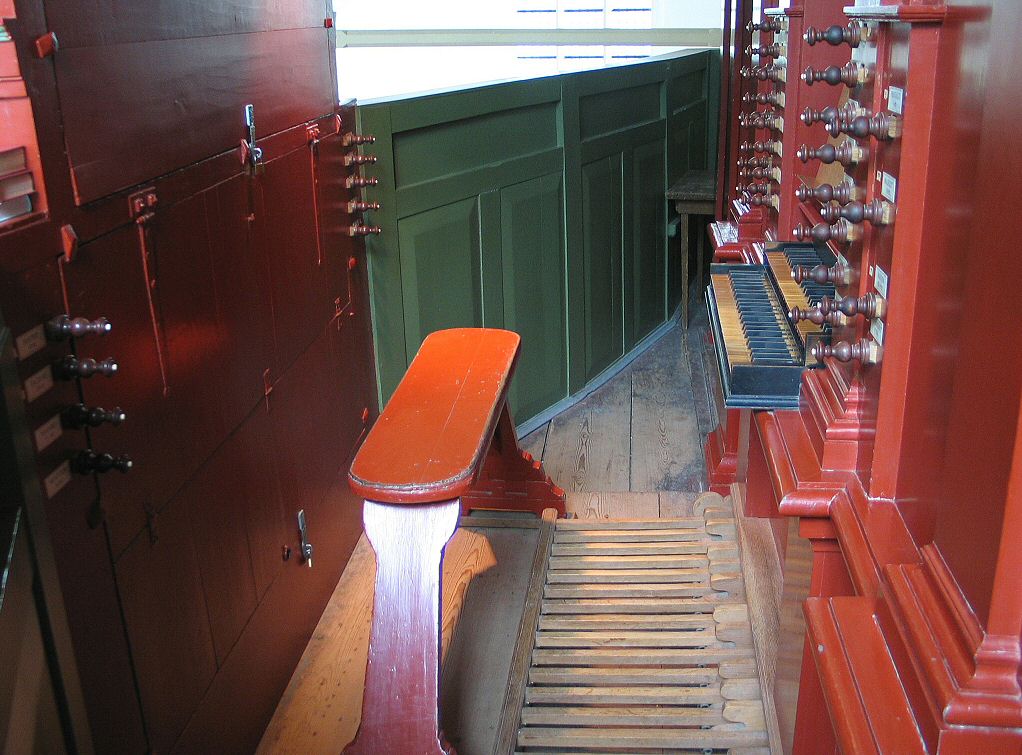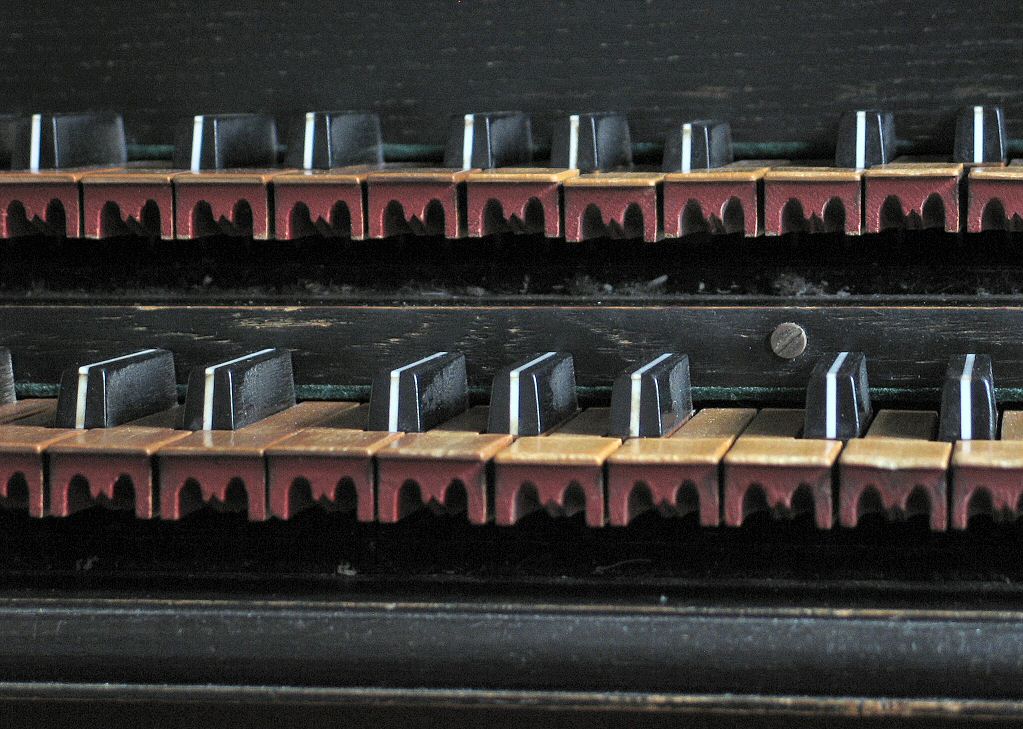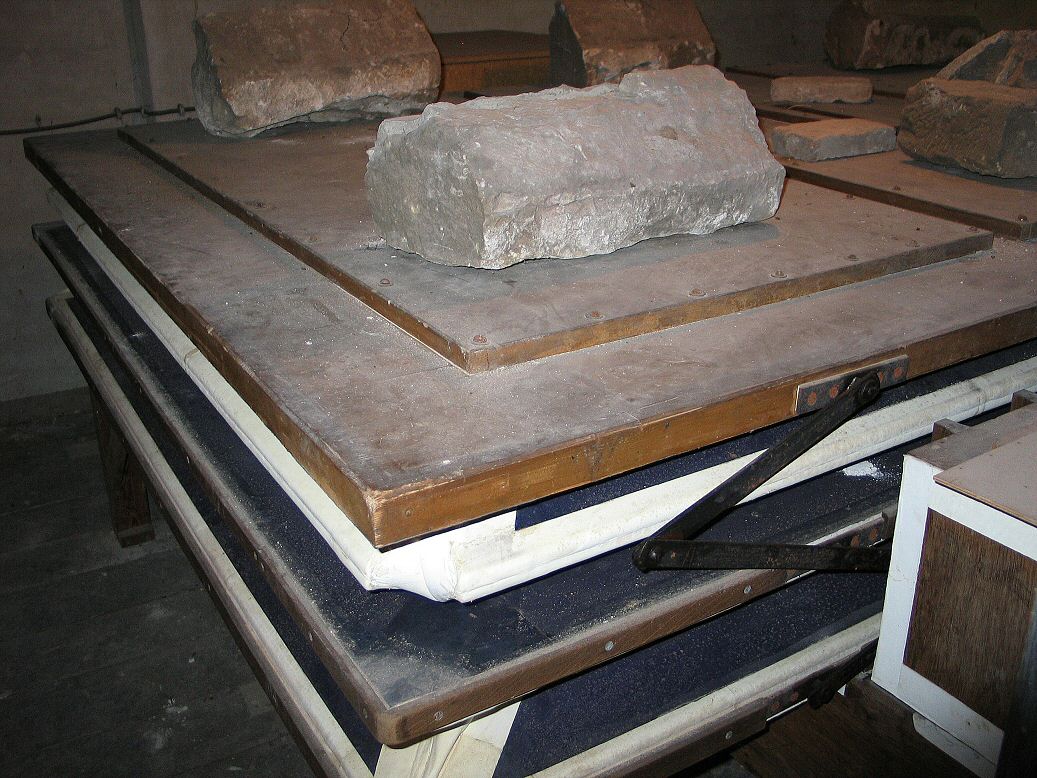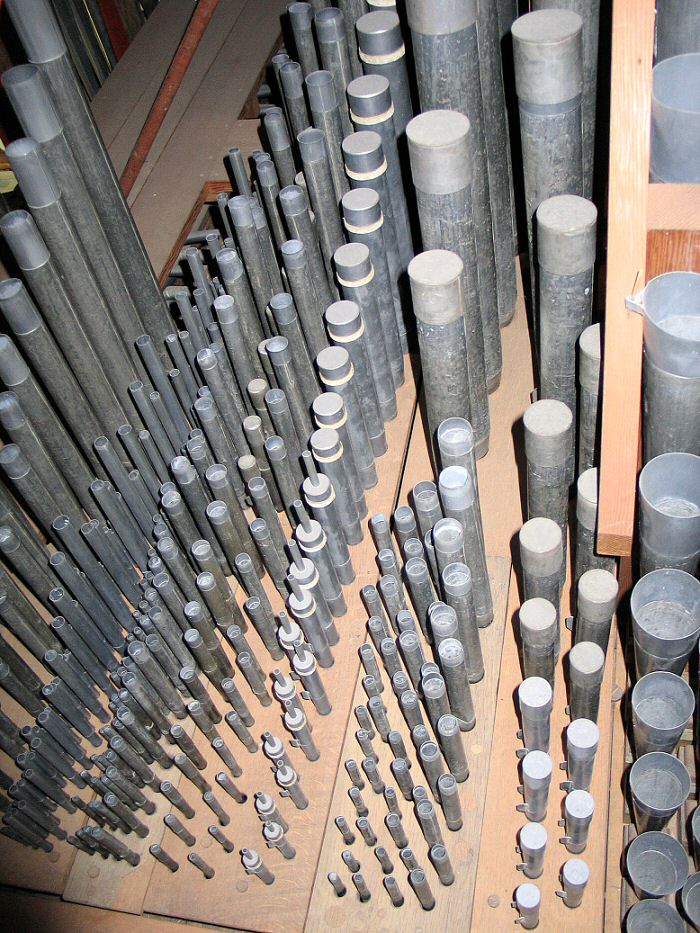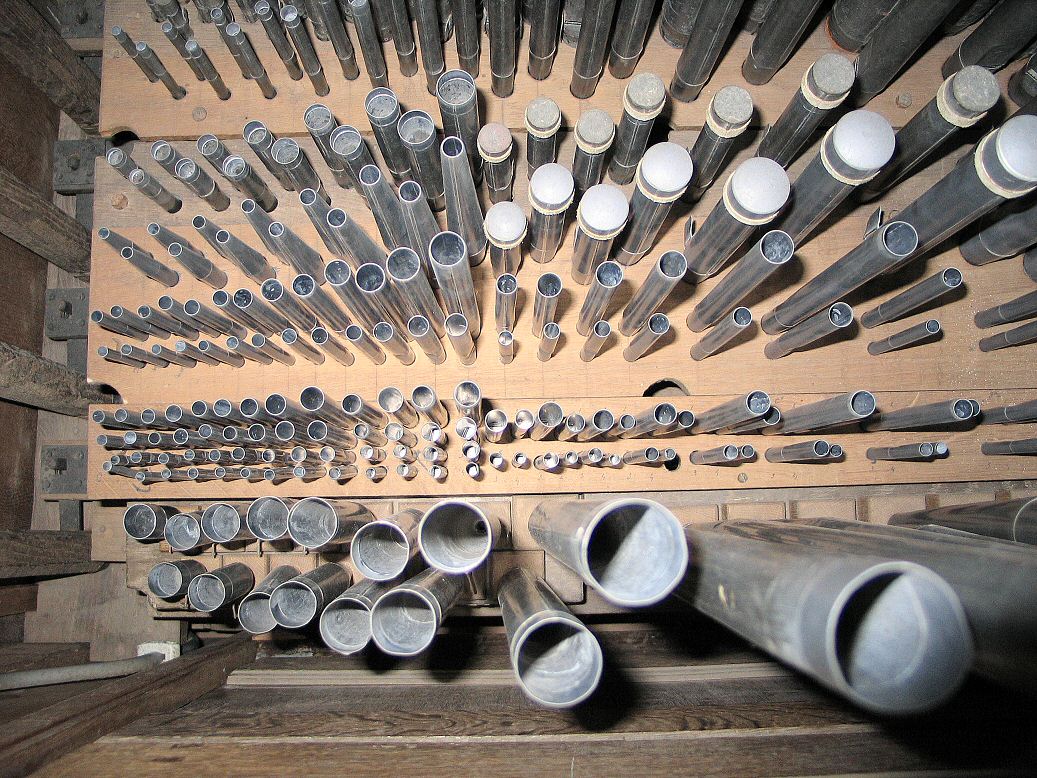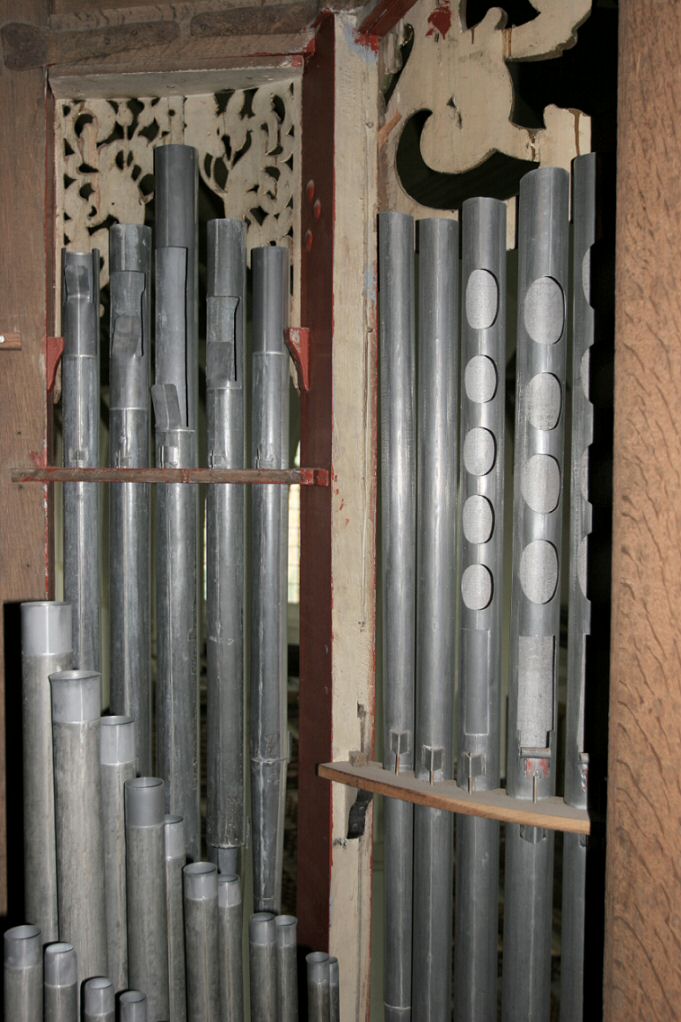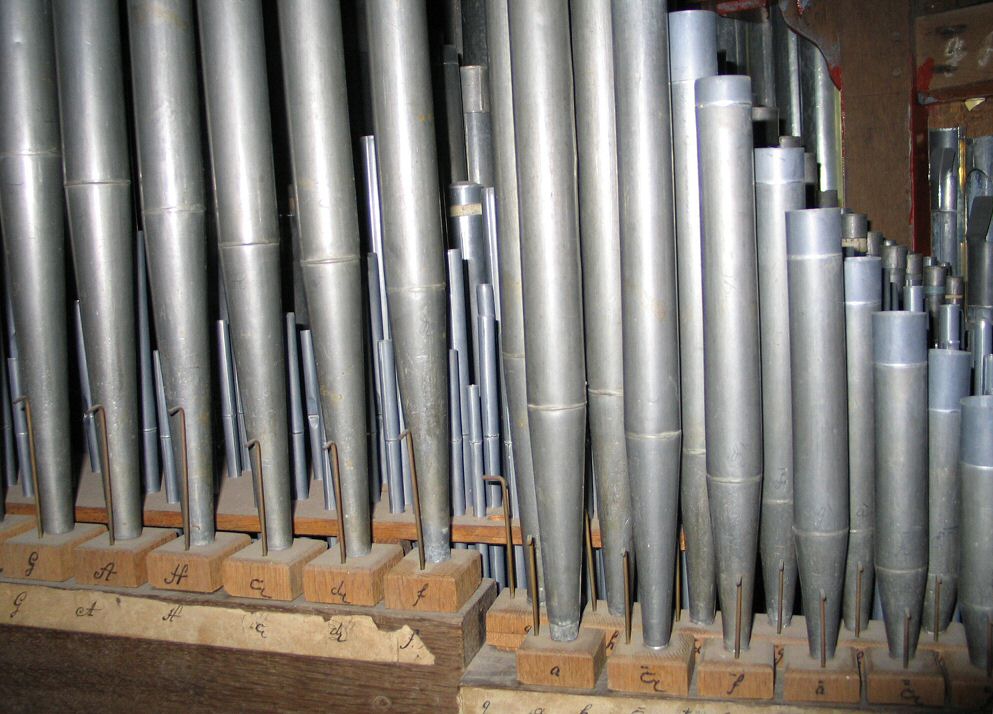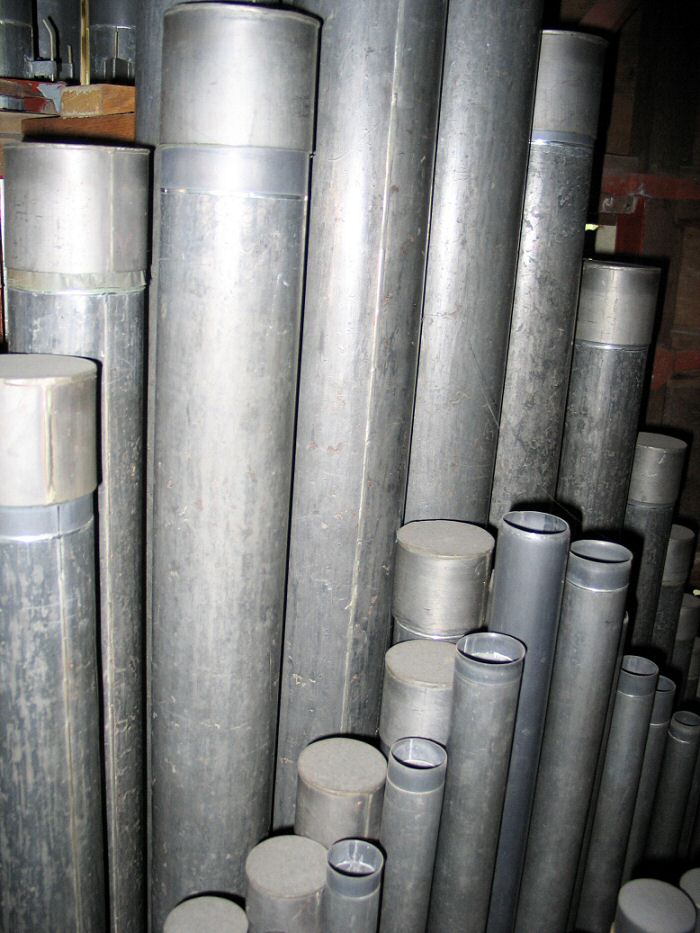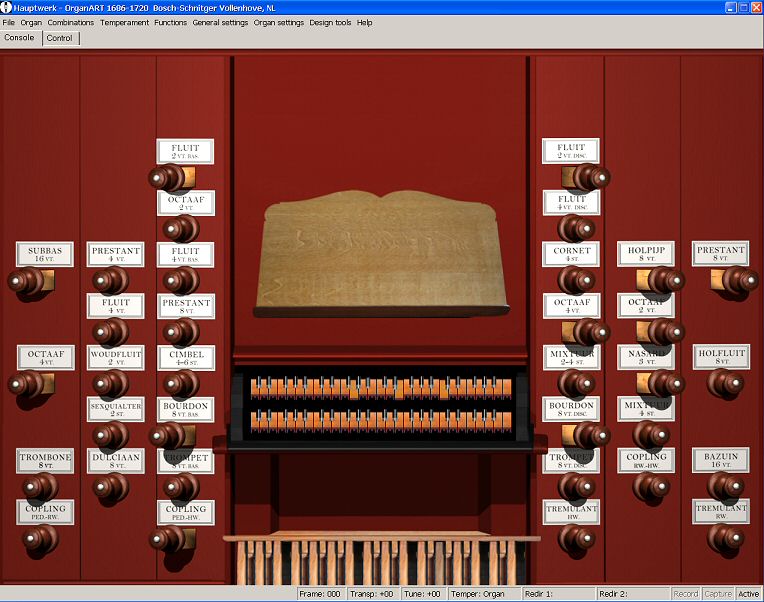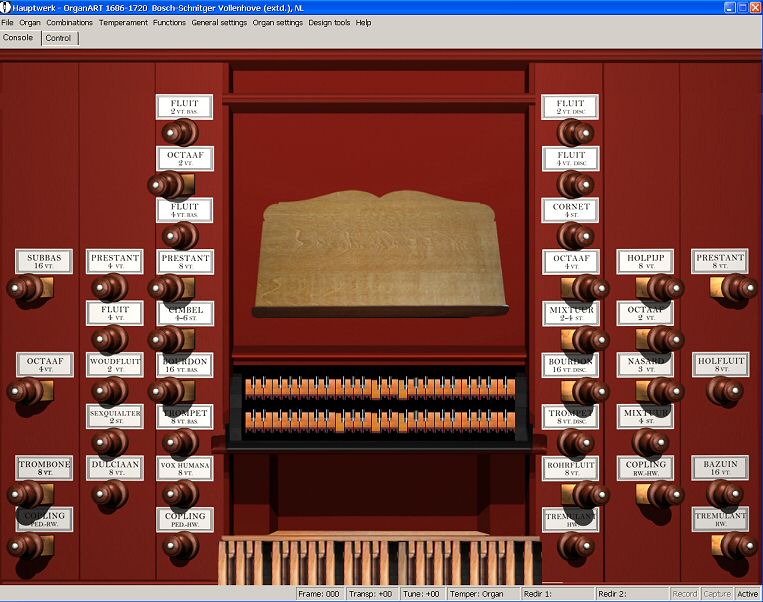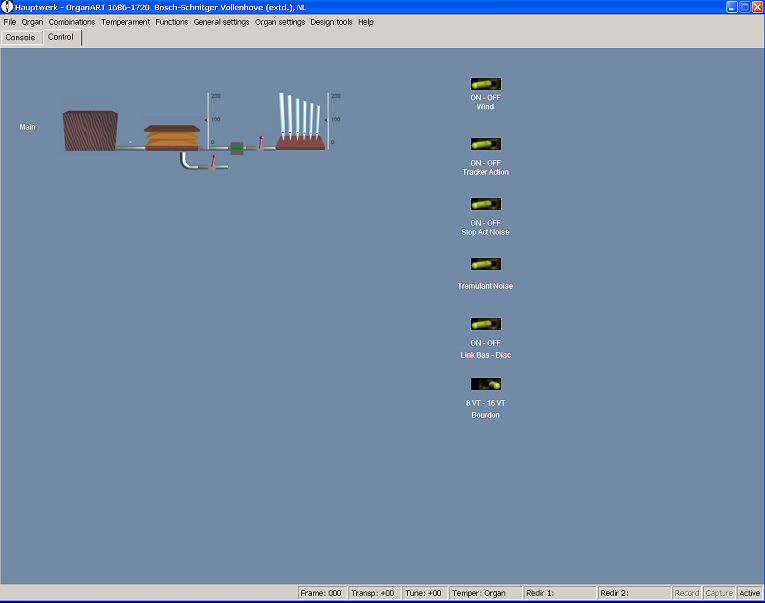1686/1720 Bosch/ F.C. Schnitger Organ
Grote of Sint Nicolaas Kerk, Vollenhove/Overijssel, The Netherlands
Short Introduction and History
In 1686 Apollonius Bosch (~1620-1699) of Amsterdam placed an organ in the church consisting of a Hoofdwerk, a Rugwerk and pull-down pedals.
Frans Caspar Schnitger was born in 1695 and learned the organ building trade from his father Arp. In 1720 Frans Caspar was commissioned to rebuild the organ in Vollenhove. It is very often said, that Frans-Caspar Schnitger was still better than his father. This is not only due to the fame of his name, but also to his majestic organ in the Grote-of St. Michaelskerk in Zwolle and his famous rebuild of the Van Hagerbeer organ in the St. Laurenskerk in Alkmaar.
Schnitger placed a new wind chest in the Rugwerk and added new stops, reeds and labials to the organ. It's assumed, that he did tonal adaptations and extensions like in the Alkmaar organ later on.
In 1860 Jan van Loo from Zwolle/Overijssel added pedal towers on each side of the Hoofdwerk case with stops of such high quality, that one is not able to hear significant differences to genuine Schnitger ranks. He added six free pedal stops, all of which are still in the organ. As usual, several modifications were made in the 19th century.
It's a luck, that all front pipes (Prestant) are still original and mostly come from 1686. The Gebroeders Van Vulpen of Utrecht restored the organ in 1977 back to 1720 while maintaining the 1860 free pedal. All of the pipes had to be lengthened to the original pitch of a’ = 415. The organ was tuned to a Werckmeister I temperament.
The organ is especially famous for its warm Prestant sounds from 1686, the bright and clear church acoustics with about 4-5 s reverberation and the quality of the Schnitger reed stops as well as the added pedal ranks. The organ is also important for its original Cornet, one of the earliest examples of this stop in the north of the Netherlands. Cornet stops are normally not to be found in Schnitger organs.
Recording technique
The organ was recorded in August 2006 with 48 kHz, 24 bit, multi-channel for Hauptwerk 2, using the new multi-layer release technique introduced by OrganART. The stops were recorded with multiple release levels for short, medium and long key attacks for optimal acoustical mapping.
Virtual Console
Specification
Organ tuning: Werckmeister I temperament at a1=420Hz
Wind pressure: 68 mm
Manual compass: C - c3 (extd. version d3)
Pedal compass: C - d1 (extd. version f1)
Hoofdwerk
(b) - Prestant 8 VT
(f/b) - Bourdon 16 VT **/ Bourdon 8 VT bas, disc
(s) - Roerfluit 8 VT bas, disc *
(b) - Octaaf 4 VT
(v) - Fluit 4 VT bas, disc
(d) - Fluit 2 VT bas, disc
(b) - Octaaf 2 VT
(b) - Mixtuur 2-4 ST
(v) - Cimbel 4-6 ST
(s) - Trompet 8 VT bas, disc
(s) - Vox Humana 8 VT *
(b) - Cornet 4 ST
Tremulant
Rugpositief
(b) - Holpijp 8 VT
(b) - Prestant 4 VT
(b) - Fluit 4 VT
(v) - Nasard 3 VT
(s) - Octaaf 2 VT
(s) - Woudfluit 2 VT
(v) - Mixtuur 4 ST (Scherp)
(v) - Sexquialter 2 ST
(s) - Dulciaan 8 VT
Tremulant, Schuifkoppel: Rugwerk + Hoofdwerk
Pedaal
(l) - Subbas 16 VT
(l) - Prestant 8 VT
(l) - Holfluit 8 VT
(l) - Octaaf 4 VT
(l) - Trombone 8 VT
(l) - Bazuin 16 VT
Copling: Pedaal + Hoofdwerk, Pedaal + Rugwerk
Note:
b: Bosch (1686)
d: Duyschot (~1700)
s: Schnitger (1720)
f: Freytag (1808)
l: Van Loo (1860)
v: Van Vulpen (1977)
VT = voet (feet)
ST = sterk (strongth, number of ranks)
Scherp = Sharp
Schuifkoppel = shove coupler, by moving keyboard backwards
Extd. Version :
* Reconstructed 1720 state:
Roerfluit: Virtual copy from F. C. Schnitger organ Duurswoude/Frisland
Vox Humana: Virtual copy from F. C. Schnitger organ Duurswoude/Frisland
** Reconstructed 1808 state: Bourdon 16 VT
Requirements
Original Version |
Memory Requirements 3) |
Processor Speeds 2) |
|
24-bit, compressed*, all loops |
3750 MB |
≥2 GHz DualCore |
|
16-bit, compressed, all loops |
2050 MB |
≥ 2 GHz DualCore |
Extended Version
|
Memory Requirements 3) |
Processor Speed |
| 24-bit, compressed*, all loops | 4300 MB | ≥2 GHz DualCore |
| 16-bit, compressed, all loops | 2300 MB | ≥2 GHz DualCore |
* Lossless compression with original sound quality!
The number of playable stops and degree of polyphony depends on processor speed and available physical memory!
2) Recommended: Minimal configuration: Dual-Core, 4 GByte main memory
3) To load this organ into Hauptwerk you will need enough free memory in your computer, due to the amount of playable stops, not including the operating system or any other programs that may be running!
We recommend a professional audio card (e.g. RME-Series) and a studio headphone (e.g. AKG Reference Headphone K701, K712) for optimal sound and room impression.
Demos
The following demo pieces (in MP3 format) were recorded with the Hauptwerk Advanced Edition software and the Bosch-Schnitger virtual organ sample set with no additional effects processing.
Live recorded demos by Anton Doornhein, NL:
J. S. Bach (1685-1750)
Toccata, Adagio et Fuga in C BWV 564
Toccata | 5:29 min Adagio | 4:40 min Fuga | 4:52 min
Trio G BWV 1027a | 3:52 min
Choral "Wenn wir in höchsten Nöthen sein" BWV 641 | 4:00 min
Choral "Liebster Jesu, wir sind hier" BWV 634 | 2:30 min
Antonie van Noordt (~1619 - ~1675)
Psalm 24 - 3 Variations
Var 1 | 1:59 min
Var 2 | 2:06 min
Var 3 | 2:26 min
D. Buxtehude (1637-1707):
Toccata in F BuxWV156 | 7:21 min
Klaas Bolt (1927 - 1990)
Improvisation on "Here kere van ons af"
from the "Valerius Nederlantsche gedenck-clanck" (1626) (transcription by Anton Doornhein, not published)
Koraal: Harmonisation by John Dowland ( HW: Fl. 4’, Vox.hum. 8’, Ped.: Bazuin 16’)
Var. 1 RW Fl. 8’ 2’(r.h.); HW Fl. 8’ (l.h.); Ped. 16’ 8’
Var. 2 RW Fl.8’ 4’ Dulc.8’ (r.h.); HW Fl.8’ 4’ (l.h.); Ped 16’ 8’
Var. 3 All Flutes (with Bourdon 16), Cymbel
Var. 4 RW Holpijp 8’
Var. 5 HW Trompet 8’(l.h.); RW Fl. 8’ 4’ 3’; Ped. 16’ 8’
Var. 6 RW Fl. 2’ trem (for the birds around the church)
Var. 7 HW Pr. Fl. 8’4’ Trompet 8’ Cornet (R.H.); RW Hp.8’ Fl 4, Pr.4, dulc.8’; Ped. 16’8’ P+RW
Var. 8 Full organ
________________________________________________________________________
Live recorded demos by Fabio Mancini, Milano, Italy:
Mean tone temperament (1/4 comma):
Paul Hofhaimer (1459-1537)
Salve Regina
Part 1: HW: Prestant 8’ , Octaaf 4’, Octaaf 2’, Mixtuur II-IV | 2:04 min
Part 2: RP: Holpijp 8', Fluit 4' | 1:00 min
D. Buxtehude (1637-1707)
Choral "Lob Gott Ihr Christen allzugleich" BuxWV 202 | 1:35 min
HW: Trompet 8', Cornet IV
RP: Holpijp 8', Fluit 4'
P: Prestant 8', Holfluit 8'
Werckmeister-I temperament (default):
J. S. Bach
Choral "Vater unser im Himmelreich" BWV 682 | 6:55 min
HW: Trompet 8', Octaaf 4'
RP: Holpijp 8', Nasat 3', Sexquialter
P: Subbas 16', Prestant 8', Octaaf 4'
Toccata d, BWV 565 | 2:48 min
Preludio et Fuga BWV 533
Preludio 2:26 min, Fuga | 2:27 min
HW: Prestant 8, Bourdon 8, Octaaf 4, Octaaf 2, Mixtuur IV, Cimbel IV-VI, Trompet 8
RP: Holpijp 8, Prestant 4, Octaaf 2, Mixtuur IV, Sexquialter, Dulciaan 8 , HW-RP
P: Subbas 16, Prestant 8, Holfluit 8, Octaaf 4, Trombone 8, Bazuin 16 , HW-P
Adriano Banchieri (Bologna 1548-1634)
"Dialogo per l'organo" | 1:16 min
HW: Prestant 8', Octaaf 4'; - Octaaf 4' ; + Prestant 4', + Mixtuur
P: Subbas 16', Prestant 8', HW-P
Hans Newsiedler (1508-1563)
Der Zeuner Tantz | 1:24 min
HW: Prestant 8, Bourdon 8, Octaaf 4, Octaaf 2, Trompet 8
RP: Prestant 4, Dulciaan 8 , HW-RP
P: Subbas 16, Prestant 8, Trombone 8, Bazuin 16 , HW-P
3rd section:
HW: + Bourdon 8, + Mixtuur
RP: + Holpijp 8, + Octaaf 2, + Mixtuur IV, + Sexquialter
P: Holfluit 8, Octaaf 4, RP-P
Numerous other live recordings can be found on the ConcertHall Website
(Advanced Search, Organ: OAM - Bosch-F.C. Schnitger, Vollenhove)
© OrganArt Media, all rights reserved
No demo sounds may be used or transmitted in any form for public purposes without the prior permission of the publisher!
Informations and Weblinks
CD-Production:Orgelconcert Grote Kerk Vollenhove (Bach, Bruhns, Buxtehude, van Noordt, Walther)
Henri Adema, Niels Adema, Ton Adema
STH Records, Nijkerk, 1410082
OAM Slide Show: 1686/1720 Bosch-Schnitger organ Vollenhove, NL

